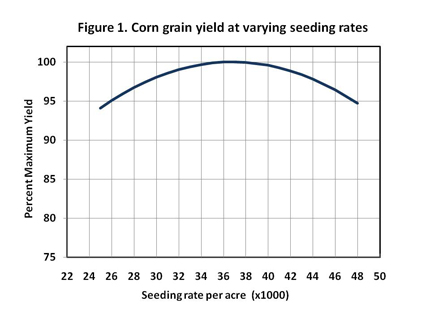Ames, Iowa
May 12, 2008
Source:
Integrated Crop Management NEWS
By Roger Elmore and Lori Abendroth, Department of Agronomy,
Iowa State University
Increased
seeding rates have ignited corn yield increases over the
years. If seeding rates are the spark, hybrid genetics fuel the
increase. It takes both high seeding rates and high-yielding
hybrids that can tolerate increased plant-to-plant competition
to maximize yields. If hybrids were not bred to tolerate
increased seeding rates, we would have fields of flat corn at
harvest. Older hybrids simply cannot tolerate today’s seeding
rates without severe lodging and/or barrenness.
As seeding rates and seed prices both increase, we must assess
whether adding an additional unit of seed covers the cost of
that seed. We discussed this topic in
an article last year. Yet, dramatic changes have occurred
since then because of high prices for both grain and seed. In
our February 2007 version we used a corn price of $3.00 per
bushel and seed prices ranging between $1.00 and $2.50 per 1,000
seed; this equated to $80 to $200 per 80,000 seed unit.
Today, an 80,000 seed unit of hybrid corn containing a triple
stack of resistant traits is priced at over $200 per unit; with
discounts that are available at times, the seed may cost
approximately $160 per unit in the end. Hybrid seed costs have
increased, for multiple reasons, with grain prices to an
all-time high.
In addition to these price changes, new research data has
accumulated concerning the response of today’s hybrids to
seeding rates.Our previous analysis of seed costs related to
maximum yield was based on seeding rate data collected by Dale
Farnham (former ISU corn agronomist) at six locations over four
years.
Our research group continues to conduct seeding rate studies
around the state, with ten locations planned for 2008. The data
summarized here is from ten research locations in 2006. Averaged
across all locations, corn yield was maximized when seeding
rates were near 36,000 seeds per acre (see Figure 1).

Figure 1. Corn yield as a percent
of maximum at varying seeding rates.
Data is averaged across 10 locations in 2006. Iowa State University.
Given this relationship and a
range in seed prices we can generate figures to better
understand where we obtain the optimum value from the seed; or
instead we could say, the maximum return to seed. Figures 2 and
3 identify the net income associated with the variation of
seeding rates and seed prices. Figure 2 displays the interaction
of these multiple factors when yield levels are near 180 bushels
per acre. Figure 3 is for yield levels near 220 bushels per
acre.

Figure 2. Variable seed prices
alter the net income associated with different seeding rates for
a field that yields 180 bushels per acre corn. Net income
derived by using a corn grain price of $5.50 per bushel and is
based solely on the seed price, seeding rate, estimated yield at
specific seeding rates, and price per bushel. Each colored line
represents the net income relative to a specific seeding rate,
with 48,000 = 48,000 seeds/acre planted. Iowa State University.

Figure 3. Variable seed prices
alter the net income associated with different seeding rates for
a field that yields 220 bushels per acre corn. Net income
derived by using a corn grain price of $5.50 per bushel and is
based solely on the seed price, seeding rate, estimated yield at
specific seeding rates, and price per bushel. Each colored line
represents the net income relative to a specific seeding rate
with 48,000 = 48,000 seeds per acre planted. Iowa State
University.
A few things are evident in an
examination of Figures 1-3.
The 36,000 seeding rate results in
maximum yield (Figure 1) and maximum net income in yield
scenarios, regardless of seed price. This is seen with the red
line being at the top in Figure 2 and 3. This was true across
all yield ranges between 180 and 240 bushels per acre (not all
data is shown here).
The 30,000 seeding rate provided a slightly lower net return
than 36,000 but was not drastically different. Producers may
need to lower their seeding rates to compensate for higher seed
costs. Notice that as seed prices increase towards $3.00 per
1000 seed unit ($240 for 80,000 unit), the difference in net
income lessens between 30,000 and 36,000.
Profitability is reduced with higher seeding rates. Note that
42,000 (blue line) and 48,000 seeds per acre (brown line) have
significantly lower net returns in both yield levels.
A 24,000 seeding rate results in lower returns and lower yields
but does not cause as serious of loss of income as the 48,000
seeding rate.
Given our current data base for seeding rate responses and the
current grain and seed price relationship, it appears that a
seeding rate of approximately 36,000 seeds per acre will
maximize not only yield but also net income. Net income will
change when seeding rates vary from this 36,000 targeted seeding
rate.
Roger Elmore is professor of agronomy with research and
extension responsibilities in corn production. Lori Abendroth is
an agronomy specialist with research and extension
responsibilities in corn production.
This article was published originally on 5/5/2008 The
information contained within the article may or may not be up to
date depending on when you are accessing the information. |
|